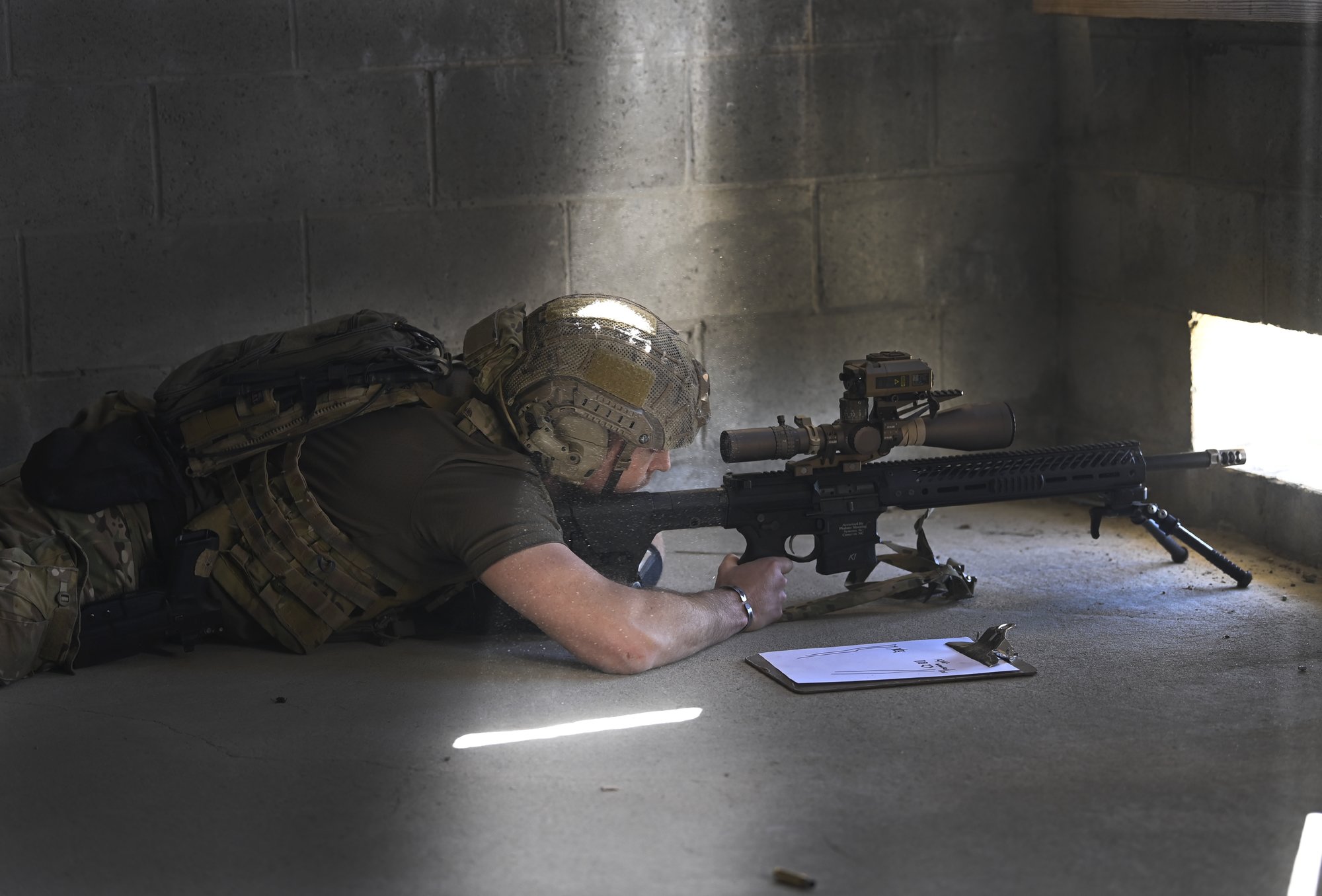
A competitor in the United States Army Special Operations Command (USASOC) International Sniper Competition looks through a riflescope while searching for long-distance targets at Fort Bragg, North Carolina, March 21, 2022. US Army photo by K. Kassens.
Just Let It Eat! Welcome to the 2022 International Sniper Competition
The enemy squad separated, four fighters scattering, running as quickly as any soldier on earth in full gear. Their training showed: From a small, bunched group, they sprinted in opposite directions so they could not all be targeted at once, rushing between the cover and concealment of walls, vehicles, and logs — never in the open for more than a few seconds.
They were headed toward a building about 200 meters away, looking for the Americans.
In the building, a pair of soldiers ran up two flights of stairs and sprawled out on a concrete floor, pushing the barrels of their sniper rifles through holes in the wall toward the attackers. The pair scanned the debris-strewn field with their naked eyes. As they spotted the oncoming enemy fighters, the Americans brought their scopes up to their eyes.
Welcome to the 2022 International Sniper Competition.

An entrant in the International Sniper Competition selects targets to engage on a range at Fort Bragg, North Carolina, March 22, 2022. US Army photos by K. Kassens.
“Orange truck, moving,” called one of the snipers as a figure darted to a brick wall from behind an orange truck. Both shooters took deep breaths, calming their breathing and heart rates, still elevated from ascending the stairs.
Two shots rang out from one shooter. Then a third.
But the second sniper didn’t fire. Instead, he spent precious seconds toying with a bulky laser rangefinder on top of his scope.
A few feet away, an instructor named DJ grinned under his ball cap. The team had made its first mistake.
“What are you doing with a rangefinder?” DJ whispered, too quietly for the shooter to hear. “They’re right in front of you! Put a reticle on center and shoot.”
The assaulters — played by human-shaped targets mounted on 600-pound, four-wheeled, armor-plated robots — were down to three but closing too fast.
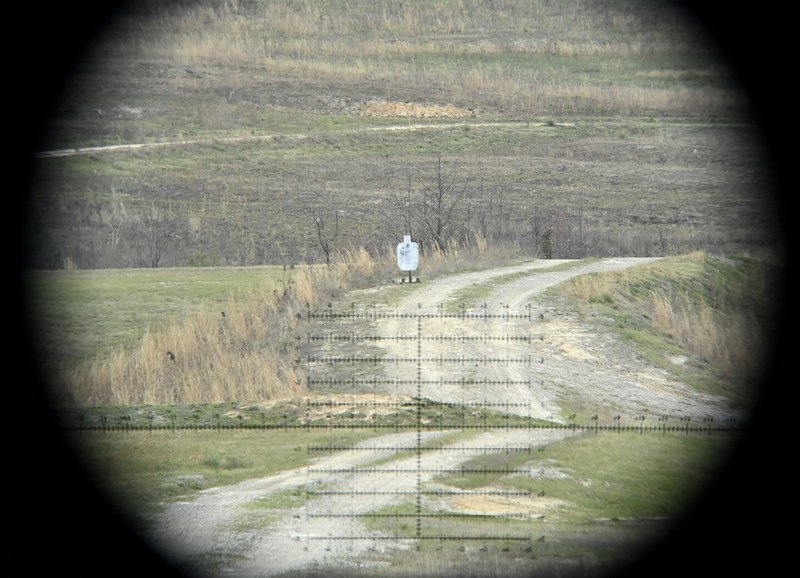
A target as seen through a spotting scope of an instructor from the United States Army John F. Kennedy Special Warfare Center and School during the United States Army Special Operations Command (USASOC) International Sniper Competition at Fort Bragg, North Carolina, March 23, 2022. US Army photo by K. Kassens.
“Behind the wall!” yelled a sniper. But the landscape in front of the team was full of walls.
“Which one?” shouted his partner.
The vague communication was the second mistake. More shots rang out.
“Reloading!” yelled a shooter, dropping a magazine from his rifle and then turning his head — away from the targets — to pull a magazine from the belt on his waist.
That was mistake No. 3.
As the two remaining robots halved their distance to the Americans, they neared a 4-foot dirt berm no more than 50 meters from the snipers. If any of the assaulters reached it, they could, in a real fight, fire back from cover, call for mortar support, or simply flank the Americans’ building.
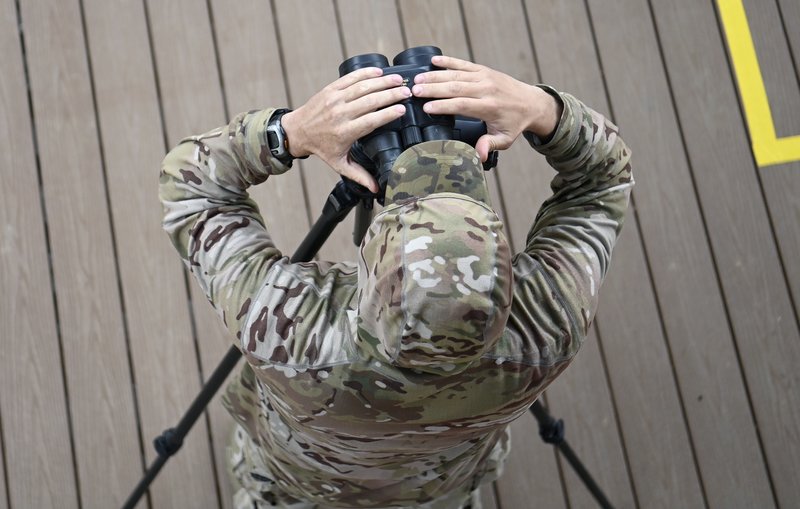
An instructor from the United States Army John F. Kennedy Special Warfare Center and School looks through binoculars to observe the accuracy of a competitor in the United States Army Special Operations Command (USASOC) International Sniper Competition at Fort Bragg, North Carolina, March 23, 2022. US Army photo by K. Kassens.
But so close, the targets filled the Americans’ field of view, making them almost impossible to miss. That presented another problem: cycling their rifles fast enough. Both shooters used .308-caliber bolt action rifles, a favorite of American military snipers. Still, each shot required the shooters to cycle the rifle manually — flipping the bolt hand up, back, then forward again — to eject the spent casing and chamber the next round.
“A lot of guys like to be super smooth with that motion,” said DJ, making a slow wave of his hand, imitating the cycling action. “But in a problem like this, you gotta run that bolt quickly, and suddenly it’s not so smooth.”
“Should have brought a gas gun,” yelled one shooter, referencing the faster rate of fire that a gas-operated rifle — which uses expended gas from a round to autoload the next shot — would allow over his manual rifle.
DJ smiled.
“The guys with gas guns, they just let it eat,” he said. A round impacted one assaulter at the berm, causing uniform pieces to fly off. He fell. Then a burst of fire stopped the second. The snipers scanned back and forth in momentary silence.
Then the final “surprise.”
“When an ODA is inside a village, from their perspective, they’re surrounded by vegetation. But from high ground, the snipers are an early warning system.”
Another figure emerged from behind the berm, charging faster than any previous fighters — this one modeled after a “suicide bomber.” Theoretically unencumbered by heavy weapons or gear, the robot-bomber was programmed to charge faster than the assaulters and not bother with an indirect path, heading straight at the snipers’ position.
DJ smiled again.
“If they get closer than the berm, you’re in the blast radius,” he said. “It’s a 30% penalty.”
“Danger close, left side!” yelled a shooter. Both men fired. Another sprinting bomber emerged from a second hole in the berm.
“Danger close, right side!”
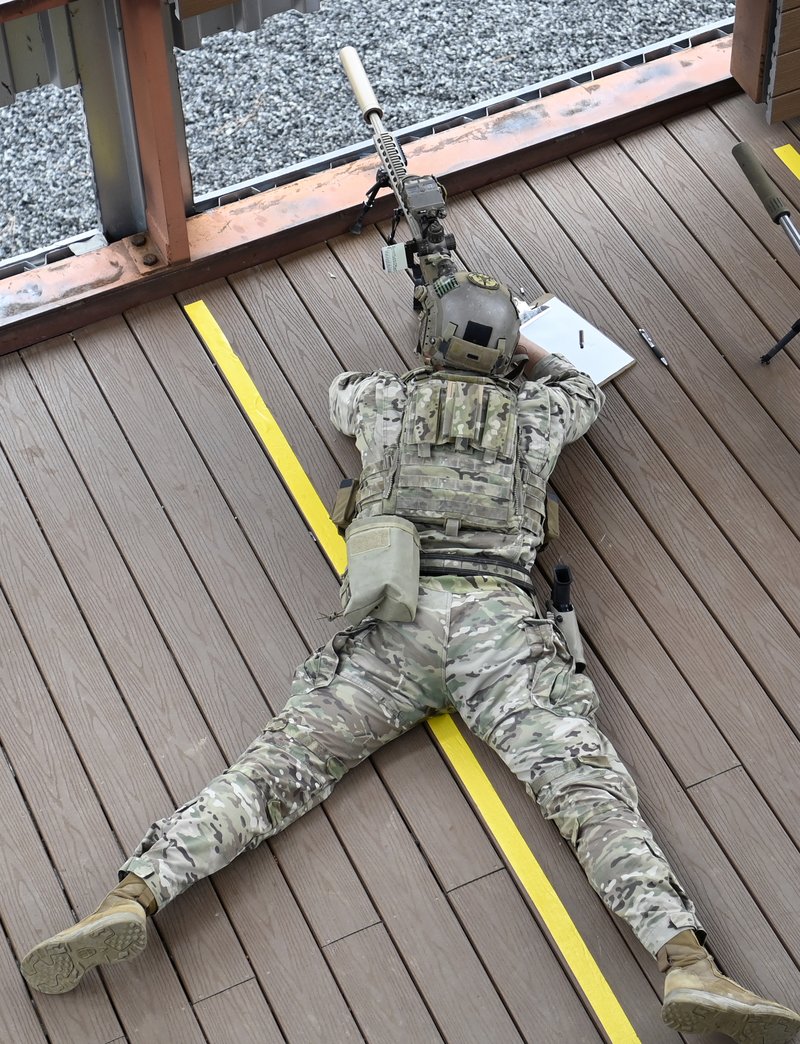
A competitor in the United States Army Special Operations Command (USASOC) International Sniper Competition, engages long-distance targets on a range at Fort Bragg, North Carolina, March 23, 2022. US Army photo by K. Kassens.
Again, shots rang out, and the bomber “fell” — the mannequin tipping backward as the robot halted, just steps past the berm.
“Lock and clear, fellas,” yelled DJ. “Good shoot!”
The two snipers, both senior US Army Special Forces veterans, looked up from the floor with wide grins and shouted hoots of approval.
“That was fun!” one of them said, excited as he cleared rounds from his weapon.
“I want to put another quarter in that machine!” his partner answered.
*****
The robot-killing drill was one of the livelier of 23 precision shooting events held over five days at the end of March during the US Army Special Operations Command’s International Sniper Competition. Over the course of a week, 21 two-man teams from the top US and international special operations units competed across more than a half-dozen ranges on Fort Bragg to test their skills and accuracy.
US competitors included military teams from every Army Special Forces group, Navy SEALs, Marine Raiders, and sniper instructors from three service branches. The field also had teams from the Coast Guard and US Secret Service. International teams came from France’s 1st SAS, Germany’s KSK, Netherlands’ Korps Commandotroepen, and Italian and Swiss special operators.
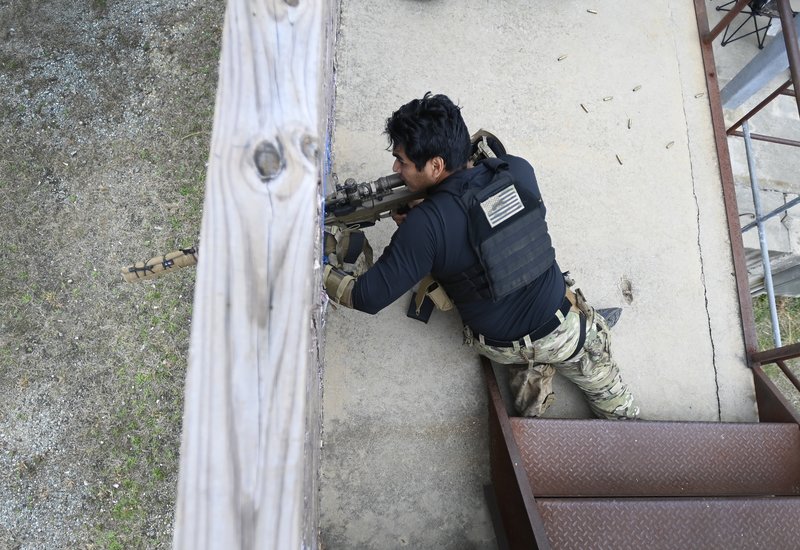
A competitor in the United States Army Special Operations Command (USASOC) International Sniper Competition, engages multiple moving targets on a range at Fort Bragg, North Carolina, March 23, 2022. US Army photo by K. Kassens.
After six days of competition, a team from the Fort Bragg-based US Army Special Operations Command was crowned the top shooters, defending that unit’s title from a year before. The Forward Observer was on hand for a handful of events.
The role of a sniper in modern special operations is threefold. The first is the obvious one in the robot gallery: marksmanship.
“We look at sniper-observer teams as an irreplaceable ground ISR capability,” said Maj. Cam, a Special Forces-qualified officer who oversees more than 20 ranges at Fort Bragg used by special operations training schools. “They also provide us with a precision finish option from a low-visibility position.”
Beyond direct targeting, the major said, snipers offer a unit — and a commander — two other primary skills: fixing a target and then defending large forces sent in on behalf of the sniper’s gathered intelligence.

Competitors in the United States Army Special Operations Command (USASOC) International Sniper Competition, engage multiple moving targets on a range at Fort Bragg, North Carolina, March 24, 2022. US Army photo by K. Kassens.
According to Cam, the ISR — intelligence, surveillance, and reconnaissance — capabilities of a sniper team are on the verge of being a lost art. Twenty years of fighting in Afghanistan and Iraq and the more recent tide of videos of drones spotting targets in Ukraine have built bad habits.
“Lots of people think of ISR as drones flying overhead or manned systems. But snipers are a form of ground ISR,” Cam said. “They have the ability to gain those atmospherics and be in location for days at a time. They can take in every detail about the environment.”
Competitions like the one at Fort Bragg are as much about reminding operators — and their leaders — of the role snipers can play as they are about clean plings on steel targets.
“We did go away from it a lot in the last conflict,” Cam said. “We didn’t want to take the risk to put snipers on a hilltop. I think that might have taken us into bad habits and almost laziness.”
“Newer guys will lose sight, but experienced guys will ride the recoil, see the impact of the miss and adjust. That’s a skill set all its own.”
He pointed to one operation in 2019 in which three Special Forces Operational Detachment Alpha teams were spread across a 10-mile Afghan valley. The weather was unpredictable and poor, limiting overhead ISR coverage. On other operations, the extended mission might have been scrubbed.
“If weather comes, it usually rolls in and shuts a lot of stuff down,” he said. “Birds can’t fly and your reliance on overhead ISR is at a point where we don’t have any MQ-9s overhead, so we will just roll our op to another day or another night.”
And scrubbed missions, he said, get noticed.
“The enemy knows if the clouds roll in, they get free range,” he said. “That would be a ridiculous way to plan, but oftentimes that was the truth.”
During the 2019 operation, the decision was made to insert sniper-observer teams.

A competitor in the United States Army Special Operations Command (USASOC) International Sniper Competition, ejects a rifle cartridge while shooting long-distance targets at Fort Bragg, North Carolina, March 22, 2022. US Army photo by K. Kassens.
“I made it clear to my highers, hey, we have ISR overwatch,” he said. “[The mission] turned out to be weeks. Because we had snipers on ridgelines, we were able to continue that multiweek effort.”
The sniper teams, he said, provided the teams in the valley with extensive information, both from their hide sites and from small, hand-launched drones they piloted themselves, flying below weather systems that kept larger aircraft away.
“When an ODA is inside a village, from their perspective, they’re surrounded by vegetation. But from high ground, the snipers are an early warning system,” he said. “It allowed us to keep ODAs on the ground without extraction ahead of weather on multiple occasions.”
*****
If observation and communication are at the heart of sniper ops, the drill at Fort Bragg’s Range 61 was a perfect test. Shooters arrived and were met by Sgt. 1st Class Josh, a physically intimidating Special Forces soldier and sniper instructor.
He told each team to bring their rifles only and prepare to shoot alone. Telling one partner to stand back and face away from the range, Josh gave the other a quick look at a printout with pictures of several targets — steel posts and silhouettes — arrayed down the length of the 1,000-meter range. Some would be at maximum distance, others as close as 400 meters.
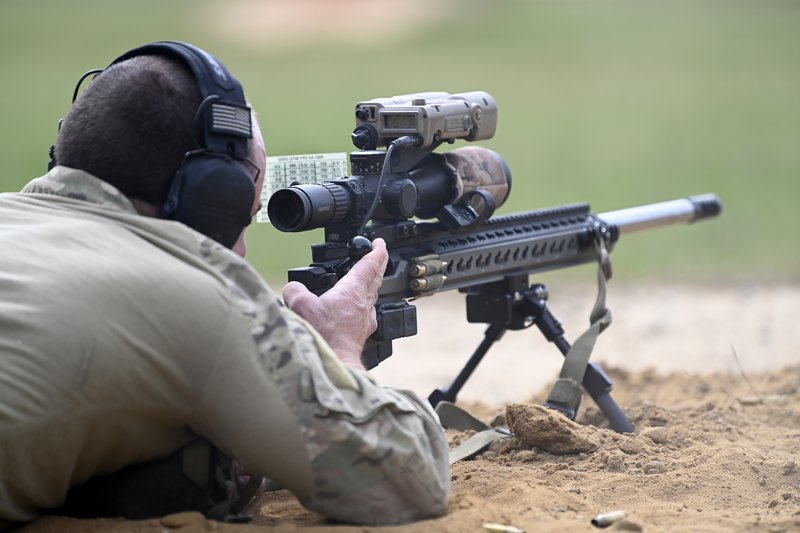
A competitor in the United States Army Special Operations Command (USASOC) International Sniper Competition, engages long-distance targets at Fort Bragg, North Carolina, March 22, 2022. US Army photo by K. Kassens.
He then gave each shooter seven rounds of ammunition. When spent, the shooters would swap positions but not be allowed to speak. The only way for the first shooter to let his partner know which of the many targets he’d hit was with a pen, a clipboard, and a single sheet of paper next to the shooting position.
Could the team pass along vital information — targets hit, ranges — if they couldn’t talk? As much as marksmanship, the drill tested whether the team could communicate target information to a teammate who could not hear or see them. The shooters would have four and a half minutes to hit as many targets as possible.
“It becomes close to a full-time job,” Tim Gozelski said. Gozelski sported a ball cap and a goatee of white hair and was the co-coordinator of the sniper competition. He invented many of the events and signed off on all of them. In the months prior, he and a small committee designed the range problems, refined the times and ammo counts, and rehearsed each one live to ensure none were too easy or too hard.
By the week of the competition, close to 50 instructors and support personnel were spread out across the base, running the show as Gozelski supervised.
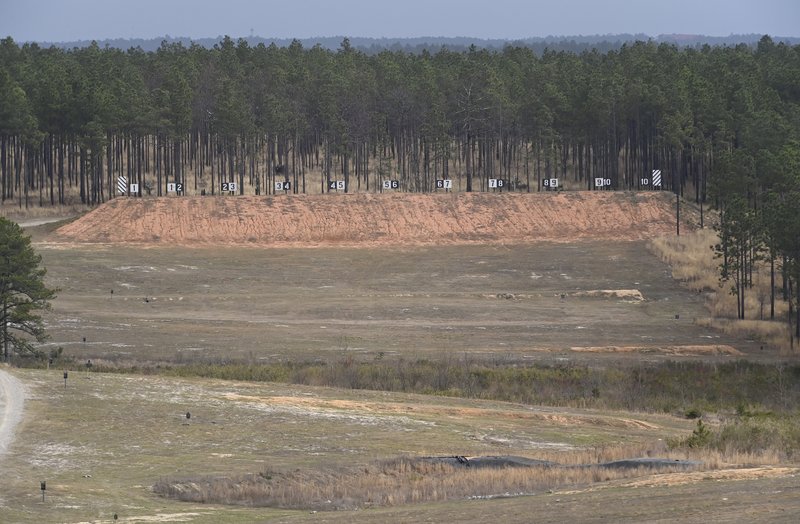
Competitors in the United States Army Special Operations Command (USASOC) International Sniper Competition, engage long-distance targets on a range like this at Fort Bragg, North Carolina, March 23, 2022. US Army photo by K. Kassens.
For the silent event, beyond the teamwork and communication issues, Gozelski and his crew had set up several sneaky marksmanship challenges. Most of the farthest targets were mounted against dirt berms or were low to the ground. If the snipers — shooting from an elevated platform — missed those targets, they had a chance to watch their bullets impact behind the target and adjust their aim if they could keep their vision through the rifle’s recoil.
“Newer guys will lose sight, but experienced guys will ride the recoil, see the impact of the miss and adjust,” Gozelski said. “That’s a skill set all its own.”
But the closer targets — inviting for a shooter worried about time and easy points — ran along the edge of the range and were mounted on poles, off the ground. As a result, a shot that missed those targets would fly back into unbroken woods, lost in shadows and depth — giving the shooter no indication of an impact to adjust his aim.
Throughout the day, instructors watched less experienced shooters home in on those “easy” targets, then waste round after round with misses, unable to correct their fire. Other, more experienced teams nailed nearly everything.
In the middle of the day’s shooting, a team of Navy SEALs took their turn. The first of the two rushed to the shooting position, but his rifle misfed. He pulled the gun’s magazine out but, when the stuck round wouldn’t drop out, placed the magazine down next to his rifle so he could reach a finger into the magazine well to dislodge the round.

Teams fire pistols at multiple targets on a range at Fort Bragg, North Carolina, March 24, 2022, during the International Sniper Competition. US Army photo by K. Kassens.
Finally, the stuck round came free, but as the SEAL grabbed the magazine to reload, he inadvertently grabbed the wrong side. Holding the magazine upside down, he tried to jam it into the rifle — a comically basic mistake for an expert shooter, but precisely the kind of miscue that the pressure of the timed drill is meant to cause.
Realizing his mistake, the man momentarily shook his head in frustration, loaded, and chambered a round. Close to 30 seconds had ticked off the clock, and the SEAL had yet to spot a target. Perhaps rushing, he fired six times, with no hits, leaving the initial misfed round unfired. Drawing a single mark on the paper, he rolled out of position, tagging out with his teammate, who quickly sprawled out and readied his rifle.
The second SEAL fired once, then twice.
“Impact, 11!” yelled Josh, watching from behind the shooter through a spotter scope. Working through his allotted shots, he hit two more targets.
Once finished, neither SEAL yelled for “another quarter in the machine,” but both grinned as they spoke briefly with Josh and Gozelski, each thanking them for the challenging exercise and training opportunity.
“All these guys can shoot,” said Gozelski. “The funnest part for us is when they come out of an event and say, ‘Oh my god, I was so not prepared.’ But they’d rather see that here than see all these things in the real world.”
Read Next: Army Rangers Take 1st Place at Marine Corps Scout Sniper Competition

Matt White is a former senior editor for Coffee or Die Magazine. He was a pararescueman in the Air Force and the Alaska Air National Guard for eight years and has more than a decade of experience in daily and magazine journalism.
BRCC and Bad Moon Print Press team up for an exclusive, limited-edition T-shirt design!
BRCC partners with Team Room Design for an exclusive T-shirt release!
Thirty Seconds Out has partnered with BRCC for an exclusive shirt design invoking the God of Winter.
Lucas O'Hara of Grizzly Forge has teamed up with BRCC for a badass, exclusive Shirt Club T-shirt design featuring his most popular knife and tiomahawk.
Coffee or Die sits down with one of the graphic designers behind Black Rifle Coffee's signature look and vibe.
Biden will award the Medal of Honor to a Vietnam War Army helicopter pilot who risked his life to save a reconnaissance team from almost certain death.
Ever wonder how much Jack Mandaville would f*ck sh*t up if he went back in time? The American Revolution didn't even see him coming.
A nearly 200-year-old West Point time capsule that at first appeared to yield little more than dust contains hidden treasure, the US Military Academy said.












